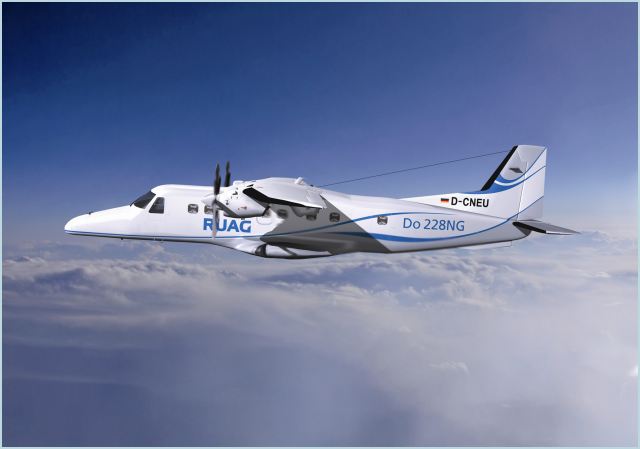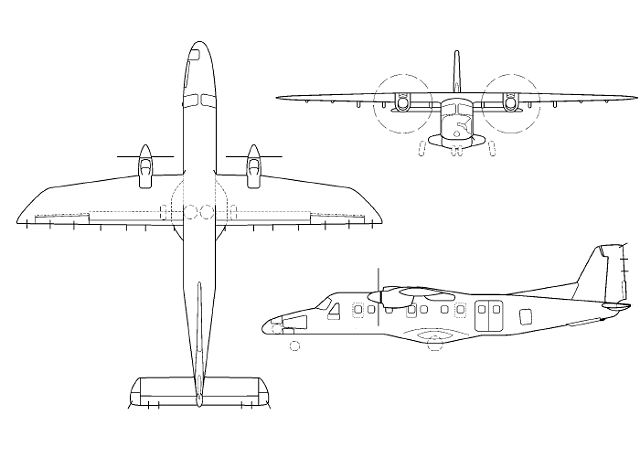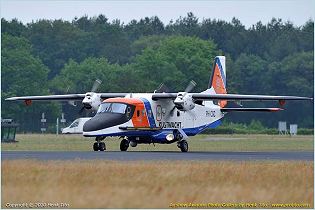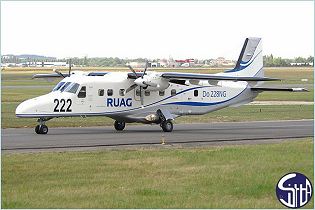Dornier 228-212 NG
| a | ||||||||||||||||||||||
|
Dornier 228-212 NG RUAG STOL multipurpose aircraft
|
||||||||||||||||||||||
 |
||||||||||||||||||||||
|
|
||||||||||||||||||||||
|
The Dornier 228-212 NG (New Generation) is a twin-turboprop STOL (short takeoff and landing) utility aircraft, manufactured by Dornier GmbH. Dornier stands for a long and successful history of airplane manufacturing. More than 25 years of experience and continuous technical improvements make Dornier 228 one of the most proven multipurpose aircraft in operation. Due to high demand RUAG Aerospace has now revived its production of Dornier 228 combining proven and stateof-the-art technology, such as a glass cockpit, 5-blade propeller and digital avionics. Dornier 228-212 New Generation is a flexible, reliable and cost-effective airplane applicable to a wide range of special mission and commuter operations. Testified by more than 250 aircraft worldwide in service. Dornier 228-212 is a multipurpose aircraft well-reputed for its reliability, versatility, economy and ruggedness. According to requirements it can transport up to 19 passengers but it is also suited to carry cargo or operate in a variety of patrol, scientific and support missions. As a true and robust STOL (short take off and landing) aircraft it is capable to start and land on unpaved runways. RUAG Aerospace’s new generation of Dornier 228 212 is equipped with modern components and systems, such as 5-blade composite propellers, digital avionics and displays and a new glass cockpit. |
||||||||||||||||||||||
| Main Variants: | ||||||||||||||||||||||
|
- Dornier 228-212 Maritime Surveillance: to be used for fishery protection, search and rescue, control of coastal waters, pollution control such as detection and tracking of oil spills, chemical waste dumping and areas of excessive algae growth
- Dornier 228-212 Ambulance: - Dornier 228-212 Cargo: - Dornier 228-212 Paratrooper: - Dornier 228-212 Airfield Calibartion: |
||||||||||||||||||||||
| Technical Data | ||||||||||||||||||||||
| Design | ||||||||||||||||||||||
|
Passengers like the Dornier 228-212 New Generation because of its comfort and spaciousness which is second-to-none compared with aircrafts of similar size and utilizability. These are some of the main advantages passengers appreciate:
• wide, light and roomy cabin • much room for head and shoulders • low interior noise Both long-range, broad-area and short-range, specific-target requirements can be met, with a variety of cabin layouts to accommodate up to five operators. The cabin can also be rapidly reconfigured for medevac, cargo or paratroop missions. The aircraft retains superb short take-off and landing capabilities, with a take-off run at maximum take-off weight of less than 700m (2,300ft) and a landing distance of 450m, plus the ability to operate from unprepared strips and in hot and high conditions. The Do 228NG retains the supercritical wing as the Do 228-212. |
||||||||||||||||||||||
| Avionics | ||||||||||||||||||||||
|
Pilots like the Dornier 228-212 New Generation with its coherent and clearly arranged cockpit. Its logical layout of controls and instruments, its modern digital displays make it a pleasure flying. It is certified for single and dual pilots operations. The Dornier 228 is equipped with an Universal UNS-1 digital glass cockpit with four 5x7in (13x18cm) multifunction displays (MFDs). As well as pilot flight, engine, and secondary aircraft information, the MFDs support precision GPS-based navigation overlaid with a terrain awareness warning system (TAWS), traffic collision and avoidance system (TCAS), electronic flightbag approach charts, weather radar, moving digital maps and electronic checklists.
|
||||||||||||||||||||||
| Propulsion | ||||||||||||||||||||||
|
The Dornier 228 NG is powered by new Honeywell TPE331-10 turboprop engines. The aircraft's new Honeywell TPE331-10 turboprop engines are derated from 940shp (700kW) to a flat-rated - up to international standard atmosphere plus 15°C - 776shp. The Dornier 228 NG has a low-level top speed of 225kt (416km/h), a typical mission range of 1,300nm (2,400km), maximum take-off weight of 6,575kg (14,500lb), maximum landing weight of 6,400kg, and fuel burn of less than 200kg per hour when on station at 4,000ft (1,220m). At a typical mission point 200nm from base, it offers more than seven hours of mission endurance. Although it can be unpressurised if required, the Do 228NG can operate at up to 25,000ft with a supplemental crew oxygen system.
|
||||||||||||||||||||||
| Missions | ||||||||||||||||||||||
|
Although the aircraft is available in corporate or commuter versions, seating up to 19 passengers, Ruag is aiming it at the intelligence, surveillance, targeting, acquisition and reconnaissance (ISTAR) market, in which it can serve as a special operations platform fitted with sideways-looking synthetic aperture radar, 360° search surveillance radar, electro-optical/infrared sensors, datalinks, a night-vision goggle-compatible cockpit, bubble-type observer/camera side windows and secure, encrypted communications.
|
||||||||||||||||||||||
| Specifications | ||||||||||||||||||||||
|
||||||||||||||||||||||
 |
||||||||||||||||||||||
|
||||||||||||||||||||||































